TONGUE-TIED BY THE TWO-TONGUES!
 Is this what Malaya'smystifying two-tongued cryptids looked like? (created by me using Grok)
Is this what Malaya'smystifying two-tongued cryptids looked like? (created by me using Grok)The days spanningChristmas and the New Year are traditionally ones filled with mystery andmagic, a time of weirdness and wonder. So what better day than today, NewYear's Eve, to present here on ShukerNature for your entertainment and enjoyumentduring this time the following cryptozoological conundrum?
In 1997, I included the following account in my book FromFlying Toads To Snakes With Wings, hoping thatsomeone reading it might be able to propose an identity for the mysteriouscreatures described, as I was thoroughly perplexed by them – but no-one everdid. Consequently, I can only assume that these cryptids left them astaxonomically tongue-tied as they have done with me. Nor have I ever uncoveredany additional information concerning them. So, 26 years later, in 2023, Ireprinted my account in my regular Alien Zoo column on mystery animals andanimal mysteries for the British magazine ForteanTimes as a fascinating crypto-riddle to ponder over during the festiveseason, just in case it did elicit a solution from someone that time. Onceagain, however, answer came there none.
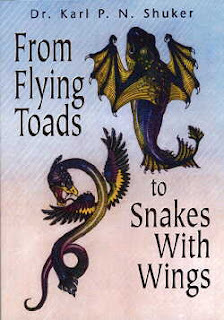 My book
FromFlying Toads To Snakes With Wings
(© Dr Karl Shuker/Llewellyn Publications)
My book
FromFlying Toads To Snakes With Wings
(© Dr Karl Shuker/Llewellyn Publications)
Consequently, one yearon from its appearance in Alien Zoo, and in the hope that the familiar phrase""third time lucky" will indeed prove true on this occasion,here yet again is the my account recalling the tangled tale of the two-tongues,in case ShukerNature's redoubtable readers can provide the long-sought key toits locked box of beastly secrets:
On May 271939, Modern Wonder documented some 'ultra-mysterious' mammals,allegedly captured by a photographer in the Malayan jungles and later observedby bemused officials in Manila, in the Philippines. Each of the beasts (ofunrecorded number) was described as being quadrupedal, weighing about 200pounds, covered in a furry, mole-like pelage (i.e. dark, dense, and shiny?),with a raccoon-like head [masked?], a pair of owl-like eyes (thus large andstaring?), and odd dentition - some of its teeth resembled a man's, others werecat-like – plus a fondness for bananas. Except for their extremely heavy weight(an error on the part of the original report?), there would seem to be a chanceof identifying them with some known animal type – until, that is, their mostdistinctive characteristic is revealed.
For thedescription also stated that each of these beasts had two tongues! Furthermore,it alleged that they never drank, because they absorbed all of the moisturethat they required directly through their skins. This is generally a feature ofcertain animals living in water or in moist habitats, but the animals concernedare normally amphibians, fishes, and lower life forms, not mammals. Conversely,it is true that many desert-dwelling rodents rarely if ever drink water,because they obtain it from their food (e.g. juicy plant tissues) or frommetabolic water released as they digest the dry components of their diet, butthey do not absorb water through their skins.
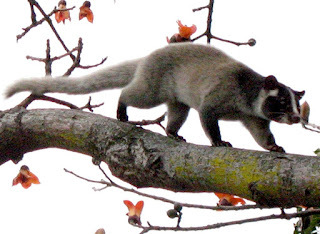 Masked palm civet Paguma larvata, native to Peninsular Malaysia, named after its raccoon-likefacial mask (© Denise Chan/Wikipedia –
CC BY-SA 2.0 licence)
Masked palm civet Paguma larvata, native to Peninsular Malaysia, named after its raccoon-likefacial mask (© Denise Chan/Wikipedia –
CC BY-SA 2.0 licence)
In generalappearance (and excluding weight), they are reminiscent of some of thelesser-known, mask-faced forms of Malay civet and badger – elusive,short-furred creatures of nocturnal lifestyle and partial to fruit within theirlargely omnivorous diet. Moreover, the owl-like eyes call to mind the tarsiers- those orb-eyed, sucker-fingered, lemur-like primates indigenous to southeastAsia (including the Malay Archipelago), and sufficiently strange in appearanceto those not familiar with these rarely-seen nocturnal creatures to attractsurprise and newspaper attention.
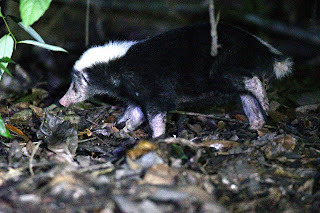 Sunda stink (=skunk) badger Mydaus javanensis, native to Indonesia andMalaysia, photographed in Malaysia (© Thompson Hyggen – copyright-free)
Sunda stink (=skunk) badger Mydaus javanensis, native to Indonesia andMalaysia, photographed in Malaysia (© Thompson Hyggen – copyright-free)
Even so,none of those identities can reconcile the mystery beasts' two tongues and theability to absorb moisture directly through their skins. Could these attributeshave been based upon misunderstanding or mistranslation, rather than uponreality? As nothing more is on record regarding the photographer's mystifyingfinds, there is no way of knowing.
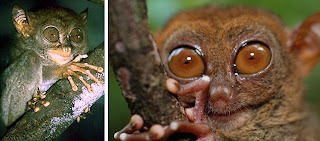 Tarsiers are nothing if not goblinesque, evenotherworldly, in appearance, especially to anyone unfamiliar with these curiousyet harmless creatures (© LDC Inc Foundation/Wikipedia –
CC BY-SA 3.0 licence
/ (© PieereFidenci/Wikipedia –
CC BY-SA 2.0 licence)
Tarsiers are nothing if not goblinesque, evenotherworldly, in appearance, especially to anyone unfamiliar with these curiousyet harmless creatures (© LDC Inc Foundation/Wikipedia –
CC BY-SA 3.0 licence
/ (© PieereFidenci/Wikipedia –
CC BY-SA 2.0 licence)
So there it is, theowl-eyed, twin-tongued, never-drinking plantain-eater – if nothing else (and confirming that I'm easily pleased!), it scanssatisfyingly like the one-eyed, one-horned, flying purple people eaterimmortalised in a classic 1958 Sheb Wooley novelty song and 30 years later in a1988 family movie directly inspired by it!
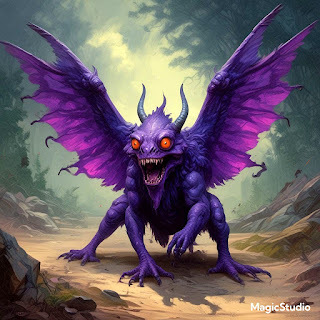 Failing abysmally in my attempts togenerate a one-eyed, one-horned, flying purple people eater, here's a two-eyed,two-horned flying purple people eater instead! (created by me usingMagicStudio)
Failing abysmally in my attempts togenerate a one-eyed, one-horned, flying purple people eater, here's a two-eyed,two-horned flying purple people eater instead! (created by me usingMagicStudio)
Meanwhile, any thoughts orsuggestions as to the two-tongues' possible identity, or any extra reports/informationregarding them, would be very gratefully received!
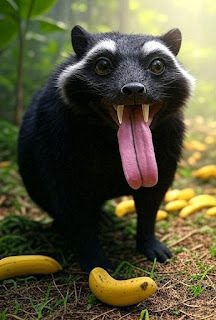 A two-tongue with a banquet of bananas awaitingits pleasure! (created by me using Grok)
A two-tongue with a banquet of bananas awaitingits pleasure! (created by me using Grok)
Incidentally, as someof you know, I've been experimenting with various AI image-generators, testingtheir capabilities and limitations so as to be better equipped to recogniseAI-generated fake cryptozoologically-themed images with which the Net seems tobe increasingly awash of late. So, as no image of the Malayan two-tongues hasever been created to my knowledge, I decided to put to the test two differentAI image-generators that I've been exploring, Grok and MagicStudio, and see howthey performed when prompted to produce pictures of these bizarre beasts.
And, as I'm sure thatthose out there who are not AI fans will be delighted to learn, both programswere aptly rendered tongue-tied (or whatever the AI equivalent state is!) bythe tortuous challenge posed by the two-tongues. Not only did they fail utterlyto depict them as the very sizeable animals that anything weighing 200 lb mustsurely be (instead presenting what look far more like diminutive cubs!), butalso, out of all the numerous images that they generated, only one, produced byGrok, actually featured creatures possessing two tongues apiece – and here itis:
 A pair of two-tongues actually depictedwith two tongues! (created by me using Grok)
A pair of two-tongues actually depictedwith two tongues! (created by me using Grok)
Overall, Grok was thesuperior creator with regard to this particular pictorial task, as it alsocreated a number of images featuring creatures with a single but bilobed tonguethat my own digital addition of a hand-drawn line separating the lobes into twoseparate tongues was sufficient to engender some satisfactory twin-tonguedentities that I've included in this article. Even so, they still did not overlyresemble the original 1977 verbal description of these creatures, quoted by meabove.
As for MagicStudio:usually a very accurate depicter of animals (give or take some extra ordeformed fingers/toes and the occasional additional leg, or two...): faced withproviding an accurate portrayal of the two-tongues, it threw a veritablegenerative gasket, and yielded some illustrations of animals that bore noresemblance whatsoever to the two-tongues' verbal description. It even garbledmy prompt for their tongues to be pink, bestowing upon its mixed-up mammals someportions of pink fur instead! However, albeit wholly inaccurate zoologically speaking,aesthetically some of the creatures thus created by MagicStudio were so attractive, appealing, and downright adorable that I couldn't bear to delete them. So here is a selection of them, in all oftheir delightful dottiness:

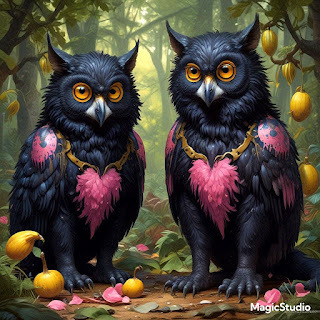
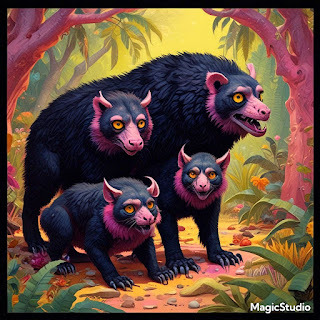 All three images created by me using MagicStudio
All three images created by me using MagicStudio
If nothing else,designers of prospective new cuddly toys could do a lot worse than be inspiredby some of these ultra-cute beasties. You can pay me my 10% creator'scommission later!
Today would have beenthe birthday of Nan, my maternal grandmother Gertrude Timmins (who onceexperienced a decidedly Fortean event of her own – click here to read all about it), whopassed away peacefully in her sleep at the grand old age of 99 back in 1994.Just like me, and also like her daughter, my mother Mary Shuker, Nan loved wildlifeand Nature in general, so I'm sure that she would have approved of my writingand presenting this fascinating fauna case here today on her birthday. Godbless you Nan, and Mom, and all of my family, all of whom are long gone now butnever forgotten by me. Ome day we shall be back together, never to be separatedagain.
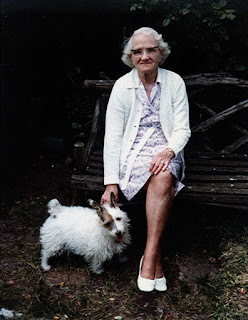 My late grandmother, Gertrude Timmins, withPatch, my little wire-haired Jack Russell terrier (© Dr Karl Shuker)
My late grandmother, Gertrude Timmins, withPatch, my little wire-haired Jack Russell terrier (© Dr Karl Shuker)
Wishing all of myShukerNature blog readers, and all of my Shuker In MovieLand blog readers too, a Happy NewYear – may 2025 prove to be a kindly, successful year for you.
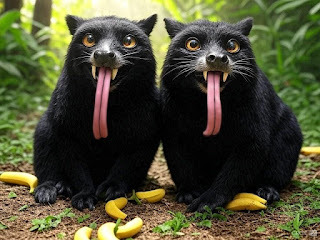 And it's toodle-pip from the two-tongues too!(created by me using Grok)
And it's toodle-pip from the two-tongues too!(created by me using Grok)
Karl Shuker's Blog
- Karl Shuker's profile
- 45 followers



